| Monthly Tech-Tip | No tracking! No ads! | |
Thixotropy
Thixotropy is a property of ceramic slurries of high water content. Thixotropic suspensions flow when moving but gel after sitting (for a few moments more depending on application). This phenomenon is helpful in getting even, drip-free glaze coverage.
Key phrases linking here: thixotropic, thixotropy - Learn more
Details
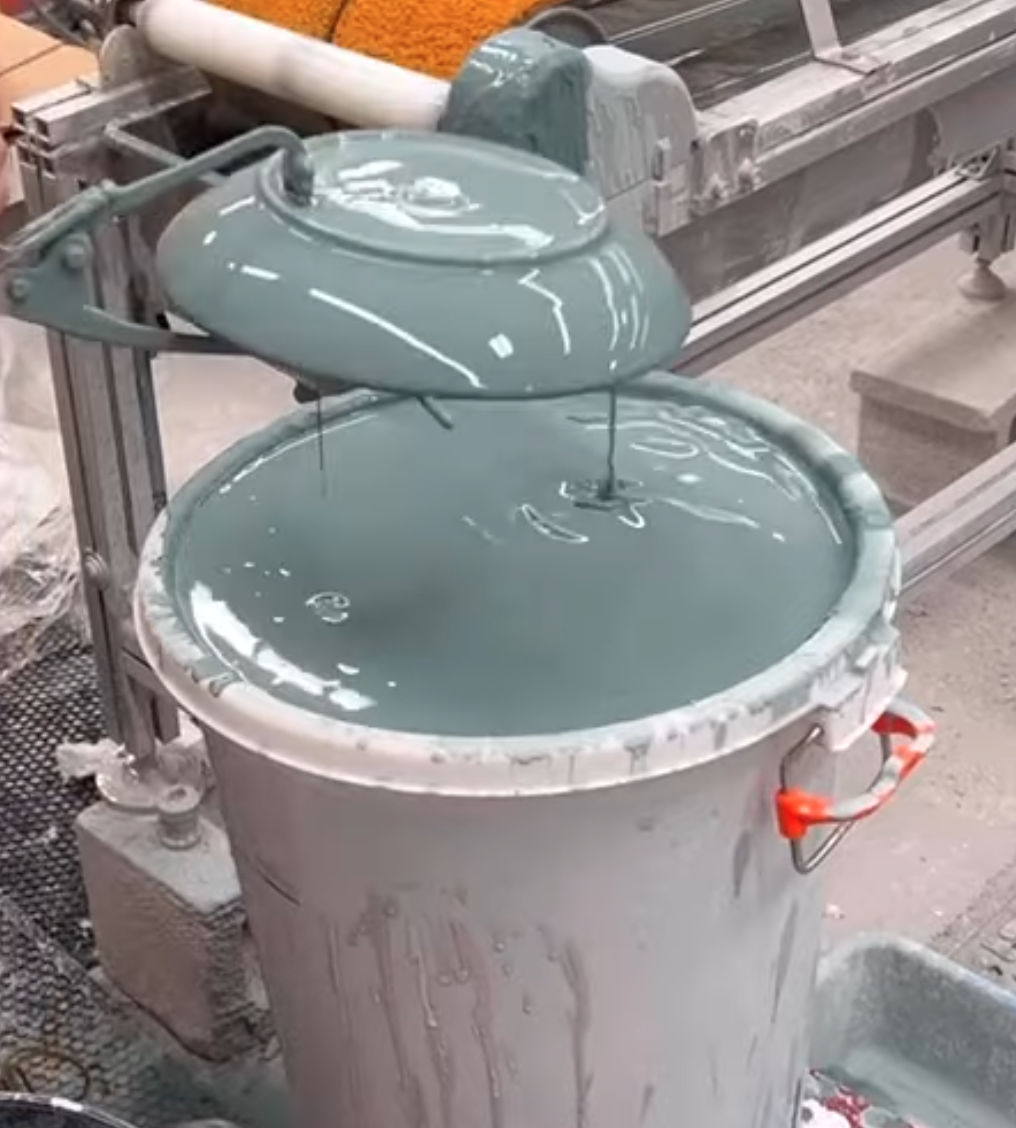
Thixotropic glaze in use at Eastfork Pottery
The term "thixotropy" refers to a decrease in the viscosity when a slurry is subjected to shearing (movement) followed by a gradual recovery to the viscous state when the movement stops. Or, in simpler terms, it is the tendency of undisturbed slip to thicken with time. A highly thixotropic slurry gels as soon as motion stops (fluid when in motion, gelled when not). Products we use every day are like this (e.g. mayonnaise, toothpaste, paints, ketchup, hair gel, these are thixotropic non-Newtonian fluids). Thixotropy measuring devices record the difference between two readings: In motion and after sitting for a fixed period.
Thixotropy is great with single layer cover glazes, ones that you want to be able to dip bisque ware into and get even coverage, no dripping and quick-drying. But, like any other non-gummed dipping glaze, additional layering is problematic. In these cases, the cover dipping glaze needs a binder, typically CMC gum (convert it to a first coat dipping glaze). There is also a kind of thixotropy where slurries of dramatically higher water content than we discuss here (e.g. 1.2 specific gravity) can be gelled by adding a high-surface-area bentonite or smectite (like Veegum or Bentone), this is done with commercial brushing glazes or slips. However, on this page, I am talking mostly about creating thixotropy without additives (other than a tiny amount of flocculant) in raw or lightly fritted slurries, these most often require near equal parts of water and powder. If your recipe contains a high percentage of clay (e.g. kaolin, ball clay, bentonite or Gerstley Borate) it may gel naturally and you won't need the method described here.
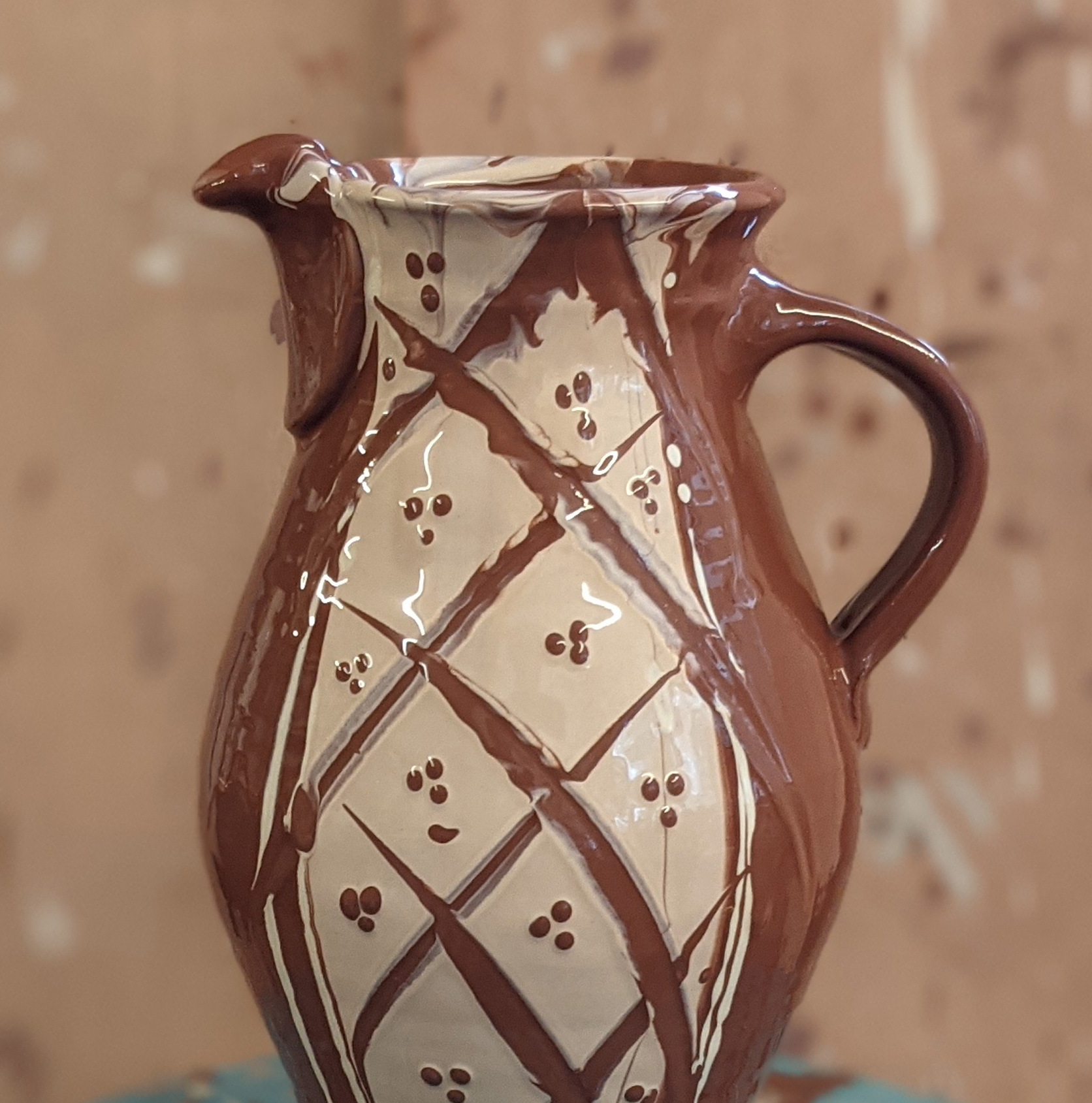
Highly thixotropic slips multilayered yet hang on
Another class of glazes deserves extra mention: Gerstley Borate recipes (GB). This material is notorious for making slurries overly thixotropic (because it is somewhat soluble). It is both a clay and a flux. When proportions go beyond about 20% it will gel the slurry, forcing the addition of more water (yet some recipes have 40% or more). Water additions do not just lower the specific gravity, but they increase drying shrinkage, thus drying cracks. This type of glaze often simply needs to be "endured". That being said, lower percentages of GB can impart nice thixotropic properties that need no further help. If a recipe contains both GB and clay and the two add up to more than 40%, then the glaze is almost beyond help, it will be a bucket of jelly no matter what you do!
Now, let's get back to typical glaze recipes: Those made from mixtures of ceramic minerals like clays (e.g. kaolin, ball clay), feldspar, silica, calcium carbonate, dolomite, talc, etc (cone 6 recipes normally add some frit). As noted, each glaze has a rheological "sweet spot", a slurry condition at which it is at its best. What is that condition in this context? When motionless it gels quickly and does not settle. During use, it is fluid, goes on evenly and does not drip. It does not dry too quickly on bisque. When it is right for me I can stir the slurry vigorously and pull out the stirring stick it will stop motion in 2-3 seconds (in a small 1-2 gallon bucket). And, it bounces back slightly! That bounce-back is the thixotropy. Normally, one cannot just mix water with a powder and get this behaviour. It is done by incorporating a flocculant.
First, one must discover the specific gravity the slurry needs to have before adding the flocculant. Mix the pre-mixed powder into about 80% of its weight in water (which should produce a slurry that is too thick for typical recipes containing 12-25% clay). Begin adding water (while propeller mixing) until it reaches a creamy consistency. For us, such a slurry will apply, in the right thickness on our bisque, using a 2-3 second dip (this is how I used to use most glazes). Does this apply to a bisque tile evenly with almost no drips? Then you are done! Otherwise, proceed.
Second, the slurry needs to be gelled (be thixotropic) so that it will stop motion in two seconds and bounce back slightly (after mixing ceases for 1-2 gallons). However, at the viscosity of the last paragraph, even a small amount of flocculant will turn the whole bucket into useless jelly. So more water is needed (remember, I am still describing how to discover the right specific gravity that will tolerate the addition of the flocculant). How much water? It might be more than you think. For us, about 5 teaspoons of vinegar are required to gel a gallon (or about 5 pinches, 2-3 grams, of powdered Epsom salts).
What next? Give a test tile a two-second dip and watch the drain characteristics. It should hang on in an even and adequate thickness, not just because of the absorbency of the bisque but the gel of the slurry. Adjust the slurry as needed according to the above. Of course, two seconds is not cast-in-stone, dip it longer if that is all that is needed to get the thickness required.
This next thing I say is key to this whole page: MEASURE THE SPECIFIC GRAVITY. And record it. That is what to mix it to next time before adding the flocculant.
Questions about making a 1.45SG slurry:
The glaze is not working right, what do I do?
Is the specific gravity correct? You cannot do anything else until that is right!
What if I have too much water in the glaze, will the vinegar still gel it?
No. If it is only a little too much Epsom salts might. Or calcium chloride. Otherwise it would be better to leave it out and evaporate some of the water.
My glaze contains carbonates and they are reacting with the vinegar, what can I do? Vinegar does not seem to work well for me, what can I do?
Use Epsom salts or calcium chloride (see link below).
Can you give me a ball-park specific gravity?
For many raw or partially fritted glazes we target 1.43-1.45 specific gravity. However, some glazes want to be fluid at higher specific gravities, so this is not a hard-fast rule (see above on how to discover the right specific gravity).
Does the temperature and age of my slurry affect its thixotropy?
Yes. Yes. Unless you have a very powerful mixer it will normally gel more over time.
What about bisque temperature?
It does not matter! With our glazes dipping time is close the same (about 3-4 seconds) if we bisque at cone 06, 05 or 04 (assuming ware is dry). That being said, pay attention to how thick it is going on and adjust immersion time accordingly. When the thixotropy is right then any clay, porous or dense, bisqued or green the thickness will glaze well! Getting control of this concept after struggling for years has revolutionized our ability to apply glazes.
Do I still need to add bentonite to my glazes?
Any glaze that has at least 10-15% kaolin or ball clay does not need bentonite when gelled like this (provided the clay is a good glaze suspender).
Why does my glaze not seem to work with this advice?
Does your glaze contain enough clay to suspend and harden on it drying? With only kaolin, they need 15%. With only ball clay about 10%. Other clays also suspend but are not typical in glazes. Gerstley borate is a suspender like clay. The Epsom salts need surface area and electrolytics that clay supplies. If there is not enough clay add a bentonite (starting with 2%). High feldspar glazes (e.g. 50%) very likely can be reformulated, using glaze chemistry, to supply the KNaO from a frit instead, this enables adding clay which keeping the overall chemistry the same.
I mixed the glaze again, got it to the right specific gravity and it is thin as water and settling in seconds after I stop stirring. Why?
You have not added the flocculant. When you do it will turn back into the beautiful gel you had last time.
The specific gravity I have determined is different than yours. Why?
The information above is based on our water (with its electrolytes), our materials, our studio, our recipes. Yours could well be different.
It is weeks later and my glaze has gone thin. What can I do?
Put in more flocculant. It will stabilize more each time you do this.
My glaze is jelly. What can I do?
First, make sure the specific gravity is not too high, we target about 1.44. If it is high (e.g. 1.48) then add water. If it is good then add a little Darvan to thin it. Be careful - a gallon of glaze might only need one drop! If you thin it too much it will be hard to thicken it again with a flocculant.
I used to have a lot higher specific gravity in my glazes than this, are you sure this is right?
I am not making a rule for all types of ceramics. For sanitary ware, for example, it is common to deflocculate glazes (to densify laydown), the opposite of what I am doing here (well, not quite, as you will see in a moment). With tight controls on production parameters they are able to maintain the rheology of the slurry at a state of controlled flocculation at 1.75 specific gravity (basically there is not quite enough deflocculant in the mix). In this state, the slurry also gels when not in motion. With the right equipment, they can spray heavy green ware achieving a dense thick laydown that dries hard and even. You would not be able to use that glaze with any of the application techniques common in a studio environment.
We slip cast ware and vessel walls are thin. At 1.43 specific gravity, the glaze waterlogs the ware, it dries slowly, cracks and then crawls in the firing. What can we do?
Find a way to enable quicker drying. Heat ware before immersing, bisque lower or glaze the insides first and let them dry and then the outsides. As noted in the previous point you may need to deflocculate the glaze to lower water content (perhaps to 1.5 specific gravity). Using Darvan it is still easy to make it quite watery, then you can gel it.
Couldn’t I deflocculate the glaze to enable lower water content and yet still have it runny and then add the flocculant to gel it?
Yes. Once you get better at this. But it produces a more fragile slurry theology, you will be adjusting it more often. And it is heavier so will form downward runs more easily on verticals.
Casting Slips
Thixotropy is more of an anti-settling strategy, ideally the slip remains fluid when in use but if allowed to stand it turns to a gel in half an hour, for example. And with casting slip we obtain that thixotropy, not by adding an acid, but by deliberately adding a smaller amount of deflocculant than what would take it to the minimum viscosity possible (again, this state is called controlled flocculation).
Engobes
Thixotropy is vitally important when using slips (engobes), especially when applied to vertical surfaces or leather hard clay (which is normal). Being able to gel an engobe is the foundation of being able to effectively apply it. Flocculated slips stay put. Engobes must be gelled more than glazes. When the consistency is right you will be amazed at how even and smooth the application will be. These more gelled slips (and glazes) also work better for spraying because you can apply a thicker wetter layer. Be aware also that a fresh application of slip re-wets the ware and will take hours to be able to handle (it adds a day to the drying cycle).
Plastic Clays
These are sometimes called thixotropic. This usually refers to material that is very elastic, can be pulled and twisted like taffy, and does not set until left still for a time.
Related Information
What to do when glazes drain and drip like this
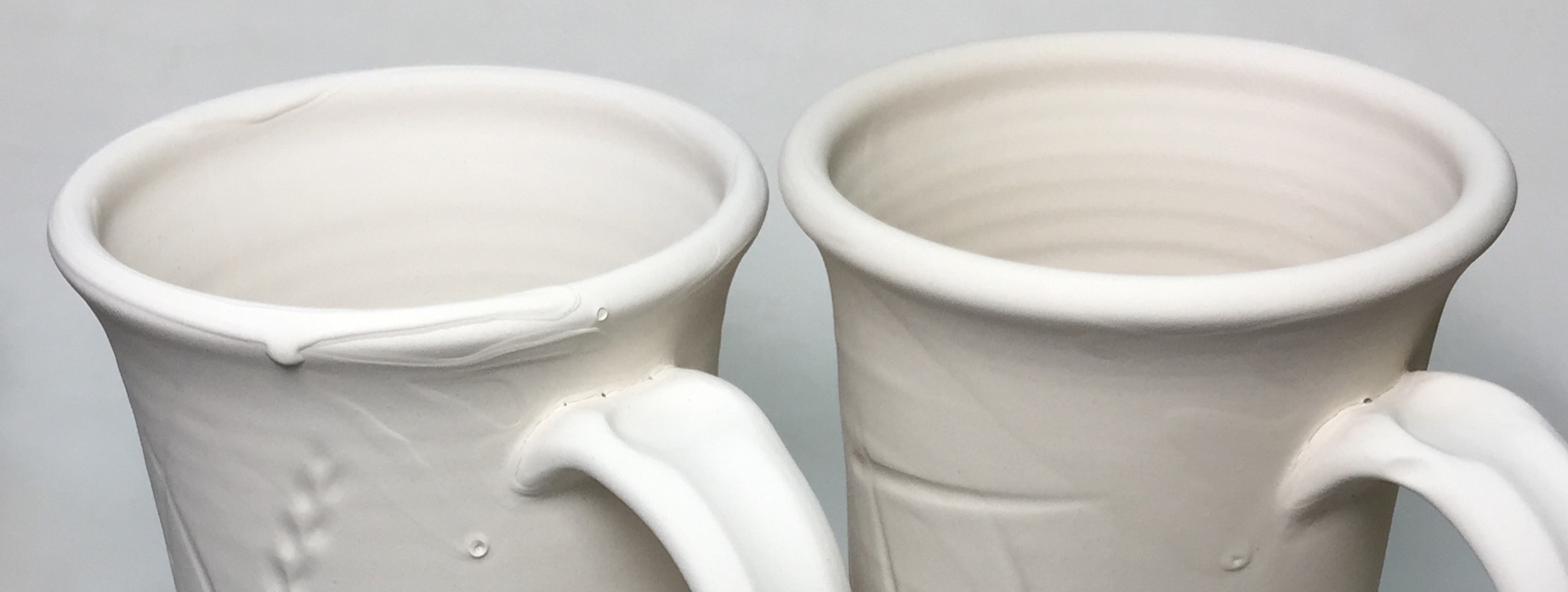
This picture has its own page with more detail, click here to see it.
These are the same dipping glaze, it is variegated and drips look ugly on fired ware. The slurry of the one on the left had a specific gravity of 1.45, it was creamy and appeared to be good. However, when this bisque porcelain mug was pulled out after the dip and rolled it formed drips on the rim. Why fix the slurry instead of just rubbing this out? Keep reading. To fix this I added water to decrease the specific gravity to 1.43. Then I added Epsom salts to induce thixotropy and gel it back to a creamy consistency. This time it went on evenly. Although the piece dries enough to handle in less than 30 seconds, it does take longer to dry completely because there is more water in the slurry. Adding CMC gum would also slow down drying but it would be very tricky to get just the right amount (otherwise dripping could be worse than this). Consider a few of the advantages of thixotropic dipping glazes: They don't settle like a rock in the bucket, they don't go on too thick or in multiple thicknesses, they don't drip and they don't dry too fast.
Glaze dunking videos reveal the value of thixotropy

This picture has its own page with more detail, click here to see it.
These videos from Eastfork Pottery demonstrate their use of thixotropic glaze slurries. Watch them to see how effective a highly gelled glaze is. It enables a quick dip, stays fluid while draining, gives even coverage and dries in seconds. These don't hard-pan or settle out in the bucket either. They work on porous or dense bisque. Almost any glaze can be thixotropic if you take the time to learn how to do it. The fast drying enables the use of twin running (or twin belt) foot wiper machines (best shown on these Instagram and Facebook videos).
Pure feldspar applied as a glaze: Possible because of the magic of thixotropy.

This picture has its own page with more detail, click here to see it.
These are pure Custer feldspar and Nepheline Syenite. The coverage is perfectly even on both. No drips. Yet no clay is present. The secret? Epsom salts. I slurried the two powders in water until the flow was like heavy cream. I added more water to thin and then started adding the Epsom salts (powdered). After only a pinch or two, they both gelled. Then I added more water and more Epsom salts until they thickened again and gelled even better. The result is a thixotropic slurry. They both applied beautifully to these porcelains. The gelled consistency prevented them from settling in seconds to a hard layer on the bucket bottom. Could you do this with pure silica? Yes! The lesson: If these will suspend by gelling with Epsom salts, then any glaze will. You never need to tolerate settling or uneven coverage for single-layer dip-glazing again!
A pure ball clay slip demonstrates thixotropy of a slurry

This picture has its own page with more detail, click here to see it.
Many ball clays create a thixotropic slurry that has beautiful application properties on leather-hard ware. Look at that big drip coming off the rim on this freshly dipped cup (left) - it is not running downward. Yet this drip dried down and likely will be barely noticeable after glazing and firing (it is bisque fired right). The rest of the surface dried thin enough to preserve the texture of the body yet completely hide its color.
Freshly slipped jug demonstrates the importance of thixotropy

This picture has its own page with more detail, click here to see it.
These thickly applied clay slips are defying gravity! This piece has just been engobed using a thixotropic brown slip. The white was applied over that by pouring and the decoration done by scoring and dripping. Both slips are very high in ball clay, no additive is necessary to make them thixotropic. The gelled state persists even with double or more the amount of water that would be in a glaze slurry. The rheology of both of these slurries, the brown underlayer and of the white overlayer, is the entire secret of how this is even possible. People who want to understand why things work come to digitalfire.com, one reader said the following about this page: "Thank you SO much for sharing this information, I have been searching for exactly what you are talking about here!" Photo courtesy of Russell Kingston, Lynmouth Slipware Pottery.
Carefully measure specific gravity using a scale and graduated cylinder
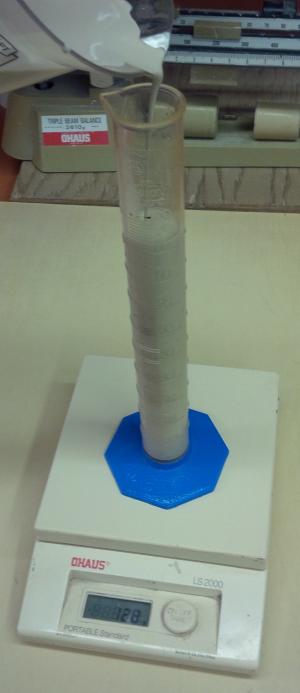
This picture has its own page with more detail, click here to see it.
This is a convenient way to measure the specific gravity of a glaze or clay slurry fairly accurately. Get a graduated cylinder like this (e.g. Amazon.com). Be careful with cheap plastic ones, check them with water and mark the true 100cc mark if needed. Counterbalance the empty graduated cylinder to zero on your 0.01g scale. Fill it to the 100 mark. The specific gravity is the weight divided by 100.
Measure specific gravity using a scale and measuring cup

This picture has its own page with more detail, click here to see it.
The specific gravity of a suspension is simply its weight compared to water (water weighs 1g per cc). For example, different glazes optimize to different specific gravities (e.g. 1.45 is typical for stoneware glazes). Casting slips typically have specific gravities of 1.75-1.8. This plastic measuring cup accommodates 500g. I have already counter-weighed it on our 0.1g scale and filled it with 500 grams of water to verify the accuracy of the 500g marking (mark the correct level with a felt pen or sticker if needed). Now, I am filling the cup with the slurry to the same level. The specific gravity is this weight divided by 500.
More problems measuring glaze specific gravity using a hydrometer

This picture has its own page with more detail, click here to see it.
Potters sometimes call this a "floating thingy". Maybe, because of the problems it presents, it does not make a big enough impression to remember the name! Because of the length of the hydrometer the only container we have is this graduated cylinder. I have to fill it just the right level so it reads near the top. OK, fine. But the hydrometer needs to bob up and down to find home. However, this glaze has our desired thixotropy, which prevents free movement. OK, I will carefully help it find home by pushing it down a little. But then it doesn’t want to bob back up! Ok, I’ll pull it up ... then is doesn't want to go back down to where it should float. Not great. Next problem: The glaze is opaque, I can’t see the reading. Yikes! A better way would be to throw out the hydrometer and just tare the empty cylinder on a scale, fill it to 100 and read the SG as the weight/100. Or fill it to any mark and divide the weight by that.
Adding water actually made this white engobe run less? How?
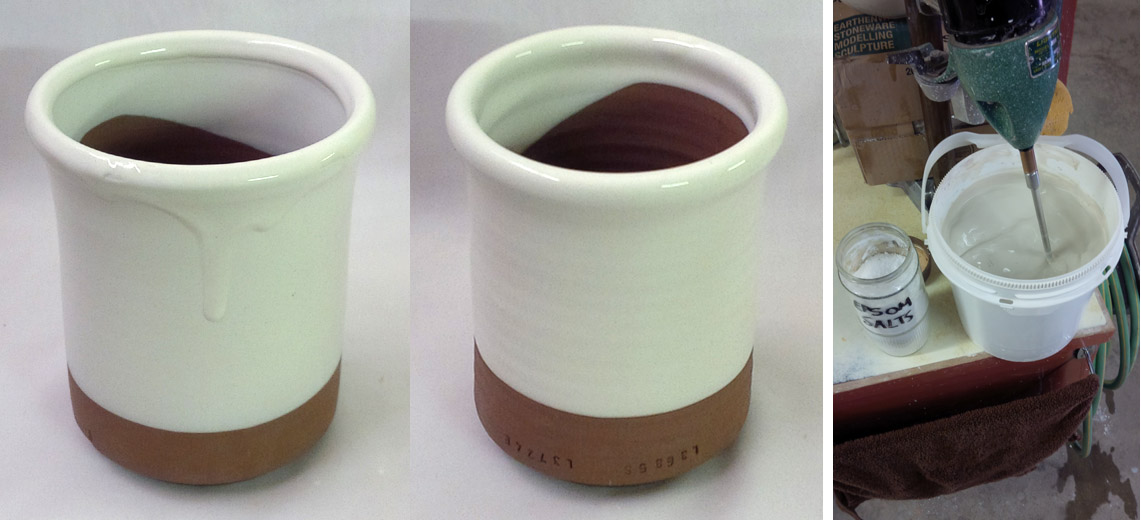
This picture has its own page with more detail, click here to see it.
The white slip (applied to a leather hard cup) on the left is dripping downward from the rim (even though it was held upside down for a couple of minutes!). Yet that slurry was very viscous with a 1.48 specific gravity. Why? Because it was not thixotropic. The fix? I watered it down to 1.46 (making it runny) and added pinches of powdered epsom salts (while mixing vigorously) until it thickened enough to stop motion in about 1-2 seconds on mixer shut-off. But that stop-motion is followed by a bounce-back. That is the thixotropy. It is easy overdo the epsom salts (gelling it too much), I add a drop or two of Darvan to rethin it if needed. When the engobe is right it gels after about 10 seconds of sitting, so I can stir it, dip and extract the mug, shake to drain it and then it gels and holds in place. Keep in mind, this is a pottery project. In industry they deflocculate engobes to reduce water content. But a deflocculated slurry can still be gelled (if it is runny).
When to use vinegar and when to use epsom salts to flocculate a slurry

This picture has its own page with more detail, click here to see it.
Slurries with more clay (like engobes, slips) generally respond better to epsom salts. However the extra clay also makes them more likely to go moldy, so you may need to add a few drops of Dettol to kill the bacteria (if they are stored for any length of time). Vinegar works better for glaze surries, but only if they have sufficient specific gravity. Many people like to make an epsom salts solution and add that, but if you have a good mixer you may find it more intuitive to add the crystals (which you should crush to a powder) and wait 30 seconds for the viscosity to respond.
I want this engobe to gel in ten seconds. Why?

This picture has its own page with more detail, click here to see it.
It is going to be applied to leather hard earthenware and it needs to be thixotropic (gelled when not in motion, liquid when in motion). Why? I do not want it to run down from the rims of the mugs after dipping. The process: Stir the engobe, pour-fill the mug, pour it out and push it upside down into the engobe. If I can pull it back out before the 10 second gel-time is up I get a perfectly even layer that does not move. A good test is to stir it then pull out the spatula slowly. If it hangs on in a even layer with only a few drips it is perfect. Achieving this behaviour requires very careful additions of powdered epsom salts (and thorough mixing between). As the slip approaches this 10 second threshold even a slight bit more salts will turn it into a bucket of jelly (if that happens I add a drop or two of Darvan). This process works across a range of specific gravities (about 1.45-1.6), the higher the SG the trickier it is (but the faster it dries).
Four drops of Davan deflocculant fixed the problem!

This picture has its own page with more detail, click here to see it.
This is a white engobe (L3954B) drying on two dark burning cone 6 stoneware leather-hard mugs (Plainsman M390). Those lumps are on the left cannot be screened out, they are agglomerates. That slip has excessive flocculant (powdered Epsom salts are added to gel it so that it stays put on the piece after dipping). About 4 drops of Darvan were added to one gallon of the slurry, this immediately made it smooth and a perfect consistency for application. It remains stable on ware (without runs). Engobes require tight control to have the right viscosity and thixotropy (which can be achieved over a range of specific gravities (about 1.45-1.6). When they are right they are a joy to use, when they are not ware is ruined.
Absolutely Jet-Black Cone 6 Engobe on M340
This could also be super white
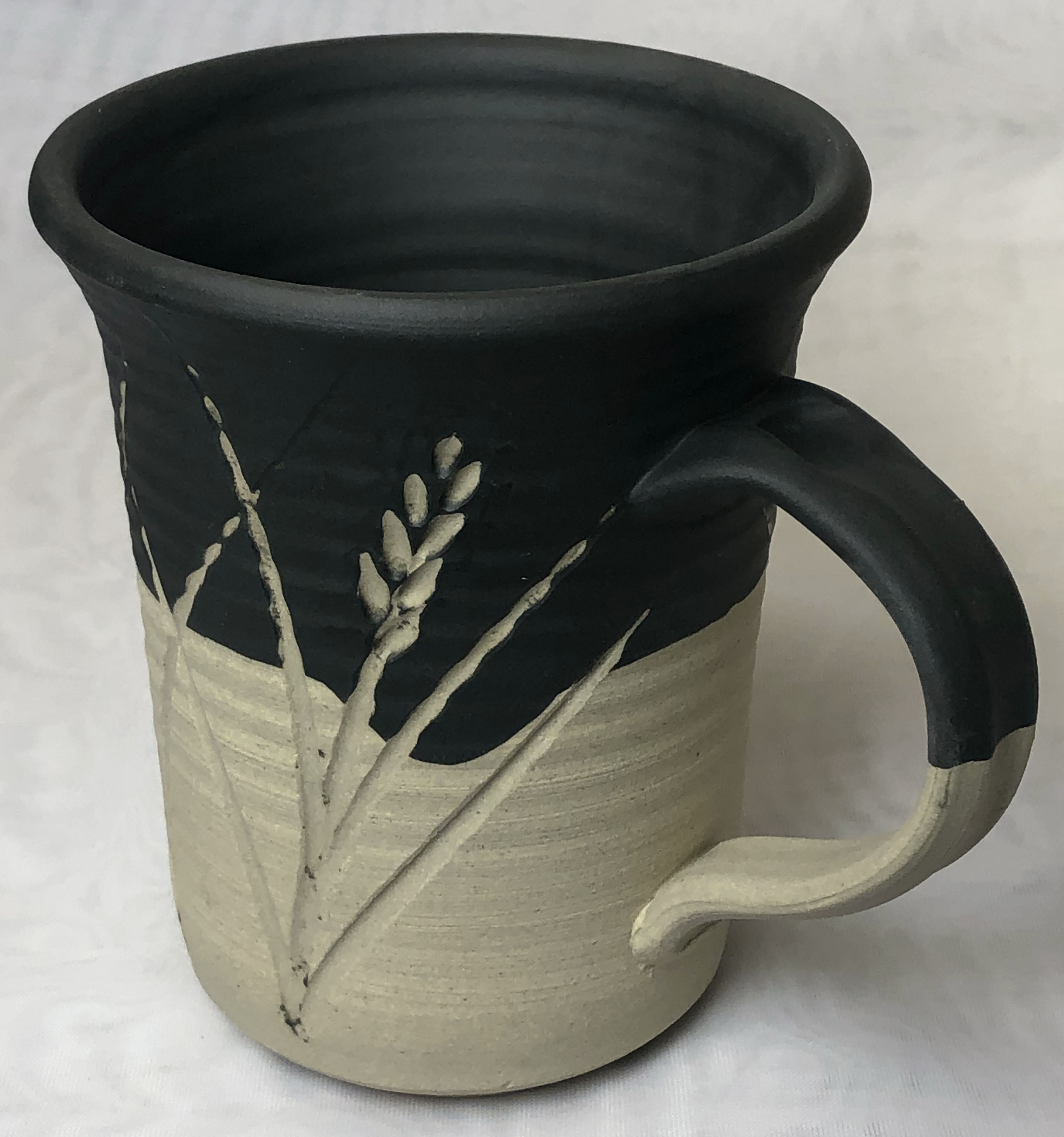
This picture has its own page with more detail, click here to see it.
This is the L3954B engobe. 15% Mason 6600 black body stain has been added (instead of the normal 10% Zircopax used for white). Of course, a cover glaze is needed for a functional surface. We put a lot of development work into producing a recipe fits this body, M340. It works even when thickly applied because it has the same fired maturity as the body. Lots of information is available on using L3954B (including mixing and adjustment instructions). Engobes are tricky to use, follow the links below to learn more. L3954B is designed to work on regular Plainsman M340 (this piece), M390 and Coffee Clay. Most important we document how to adjust its maturity, and thus firing shrinkage, to fine tune fit if needed. These bodies dry better than porcelains and are much less expensive, so coating them with an engobe to get a surface like this makes a lot of sense. Ed Phillipson discovered this 80 years ago, enabling selling pieces made from these clays as white hotel ware.
Fundamentals of Fluid Mechanics - book

This picture has its own page with more detail, click here to see it.
Many aspects of ceramic production relate to the control of fluids (mostly suspensions). This is also true of material production. If you want to solve problems and optimize your process this is invaluable knowledge. This book is available at amazon.com.
Inbound Photo Links
Links
| Glossary |
Rheology
In ceramics, this term refers to the flow and gel properties of a glaze or body suspension (made from water and mineral powders, with possible additives, deflocculants, modifiers). |
| Glossary |
Deflocculation
Deflocculation is the magic behind the ceramic casting process, it enables slurries having impossibly low water contents and ware having amazingly low drying shrinkage |
| Glossary |
Flocculation
The flocculation process enables technicians in ceramics to create an engobe or glaze slurry that gels and goes on to ware in a thick yet even, non-dripping layer. |
| Glossary |
Viscosity
In ceramic slurries (especially casting slips, but also glazes) the degree of fluidity of the suspension is important to its performance. |
| Glossary |
Specific gravity
In ceramics, the specific gravity of slurries tells us their water-to-solids ratio. That ratio is a key indicator of performance and enabler of consistency. |
| Glossary |
Colloid
In ceramics some clays of are of such exceedingly small particle sizes that they can stay in suspension in water indefinitely. But unlike common colloids, clays have a secret weapon. |
| Glossary |
Glaze Layering
In hobby ceramics and pottery it is common to layer glazes for visual effects. Using brush-on glazes it is easy. But how to do it with dipping glazes? Or apply brush-ons on to dipped base coats? |
| Glossary |
Suspension
In ceramics, glazes are slurries. They consist of water and undissolved powders kept in suspension by clay particles. You have much more control over the properties than you might think. |
| Glossary |
Engobe
Engobes are high-clay slurries that are applied to leather hard or dry ceramics. They fire opaque and are used for functional or decorative purposes. They are formulated to match the firing shrinkage and thermal expansion of the body. |
| Glossary |
Raku
Gas fired rustic ceramic ware is cooled from red-hot in a closed container with organic material. The zero-oxygen atmosphere produced reduces carbonate metal decoration to its metallic form. |
| Glossary |
Dipping Glaze
In traditional ceramics and pottery dipping glazes can be of two main types: For single layer and for application of other layers overtop. Understanding the difference is important. |
| Glossary |
Base-Coat Dipping Glaze
These are ceramic glazes intended for dipping but which contain a gum to enable them to adhere to the body better and tolerate over-layers without danger of flaking or cracking. |
| Tests |
Rheology of a Ceramic Slurry
|
| Troubles |
Uneven Glaze Coverage
The secret to getting event glaze coverage lies in understanding how to make thixotropy, specific gravity and viscosity work for you |
| Troubles |
Powdering, Cracking and Settling Glazes
Powdering and dusting glazes are difficult and a dust hazard. Shrinking and cracking glazes fall off and crawl. The cause is the wrong amount or type of clay. |
| Materials |
Epsom Salts
|
| Materials |
Vinegar
|
| Materials |
Calcium Chloride
|
| Materials |
EP Kaolin
A kaolin that gels slurries (thus handy to suspend ceramic glazes). It is plastic and fires white enough that it is also valuable in porcelain bodies. |
| Materials |
Acti-Gel 208
|
| Media |
Thixotropy and How to Gel a Ceramic Glaze
I will show you why thixotropy is so important. Glazes that you have never been able to suspend or apply evenly will work beautifully. |
| Media |
How to Apply a White Slip to Terra Cotta Ware
I will show you some secrets of making a base engobe (or slip) apply to leather hard terracotta ware in a thick, perfectly even layer. |
| Media |
Adjusting the Thixotropy of an Engobe for Pottery
How to fine-tune the thixotropy of a ceramic engobe for pottery |
Video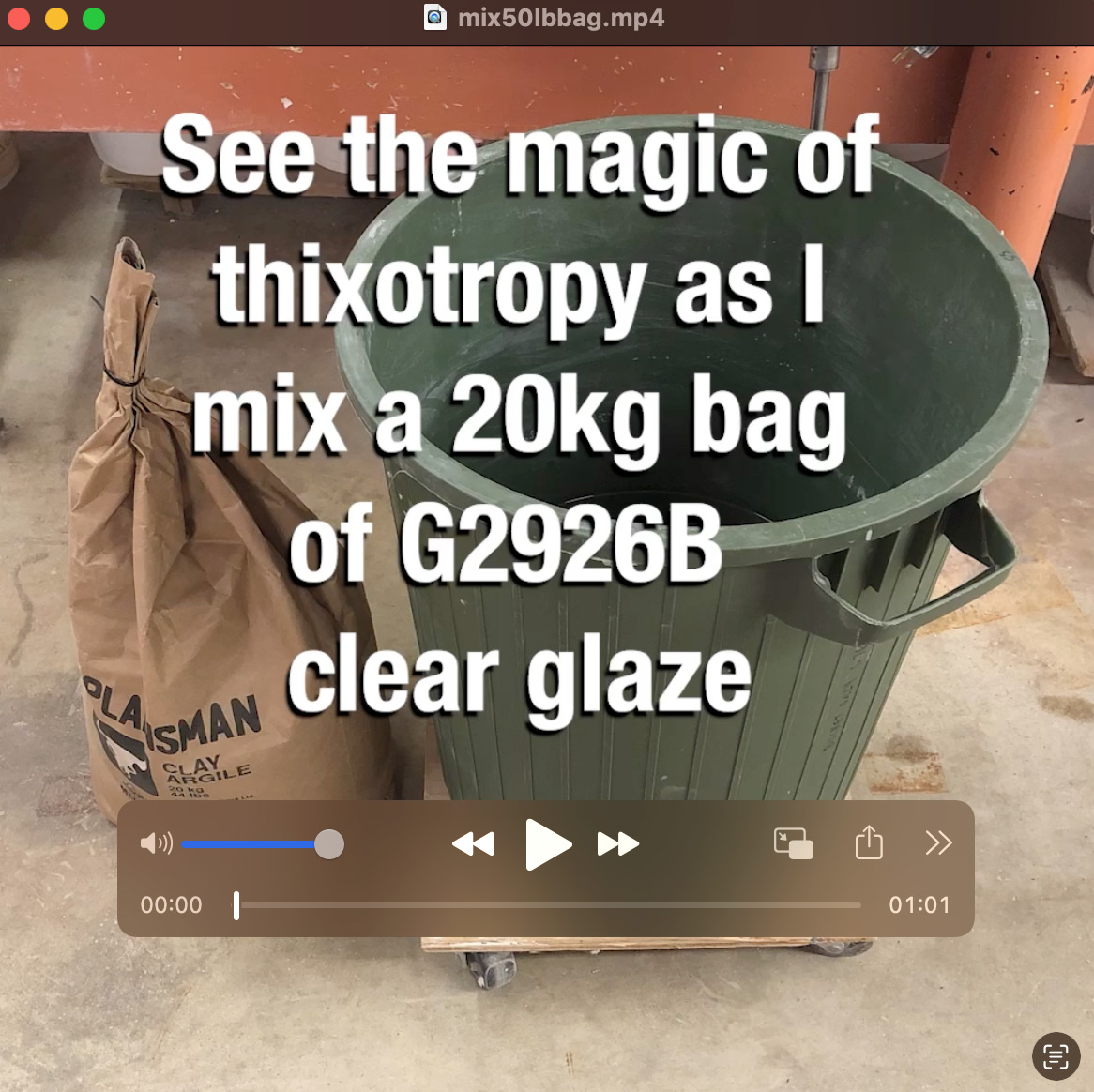 |
Watch Thixotropy Happen With a 20kg Batch of Dipping Glaze
I mixed 20kg of glaze powder into 20kg of water, turned out super watery. Yet the specific gravity was 1.46, too high. How? But, instead of more water, I added Epsom salts—and boom: A perfect thixotropic gel. It glides on smooth, no drips, no thickness issues. |
| Recipes |
G3806C - Cone 6 Clear Fluid-Melt transparent glaze
A base fluid-melt glaze recipe developed by Tony Hansen. With colorant additions it forms reactive melts that variegate and run. It is more resistant to crazing than others. |
| Recipes |
G1916Q - Low Fire Highly-Expansion-Adjustable Transparent
An expansion-adjustable cone 04 transparent glaze made using three common Ferro frits (low and high expansion), it produces an easy-to-use slurry. |
| Recipes |
G2934 - Matte Glaze Base for Cone 6
A base MgO matte glaze recipe fires to a hard utilitarian surface and has very good working properties. Blend in the glossy if it is too matte. |
| Recipes |
GR6-M - Ravenscrag Cone 6 Floating Blue
Plainsman Cone 6 Ravenscrag Slip based version of the popular floating blue recipe. |
| Recipes |
G2926B - Cone 6 Whiteware/Porcelain transparent glaze
A base transparent glaze recipe created by Tony Hansen, it fires high gloss and ultra clear with low melt mobility. |
| Articles |
Where do I start in understanding glazes?
Break your addiction to online recipes that don't work or bottled expensive glazes that you could DIY. Learn why glazes fire as they do. Why each material is used. How to create perfect dipping and brushing properties. Even some chemistry. |
| By Tony Hansen Follow me on        |  |
Got a Question?
Buy me a coffee and we can talk

https://digitalfire.com, All Rights Reserved
Privacy Policy




